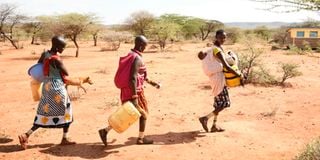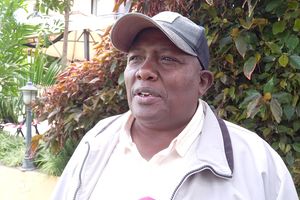Drought now declared national disaster

Baringo, Kwale, Laikipia, Kitui, West Pokot and Lamu are among counties at risk of severe food shortages.
President Uhuru Kenyatta yesterday declared the drought ravaging parts of the country a national disaster.
The declaration comes just a month after the National Drought Management Authority (NDMA) said an estimated 2.1 million Kenyans face acute food shortage and would be in urgent need of assistance in the coming six months.
This was a rise of more than 600,000 people from the 1.4 million Kenyans the government in April said faced hunger due to the drought and the effects of the Covid-19 pandemic.
The figure was corroborated by the Kenya Red Cross Society, with its Secretary General, Asha Mohammed, saying 12 arid and semi-arid counties are the most affected.
The situation, Ms Mohammed added, is likely to become worse and affect up to 20 counties if authorities do not act quickly enough.
President Kenyatta made the declaration after a meeting with Treasury Cabinet Secretary Ukur Yatani and 85 leaders from Arid and Semi-Arid Lands (Asal).
Desert locusts
Consequently, Mr Kenyatta instructed the National Treasury and the Ministry of Interior to spearhead government efforts in assisting the affected households and regions.
The efforts, the President said, include distributing water and relief food as well as buying livestock.
“Details of the government’s comprehensive drought mitigation measures will be made public in due course,” State House spokesperson Kanze Dena-Mararo said.
According to NDMA, the deterioration of the food security situation in Kenya is due to the dismal performance of the March-May long rains, the short rains and the effects of the pandemic.
The situation, the authority added, was exacerbated by the desert locust invasion.
The report said the number of people facing acute hunger would grow to 2.4 million during the October-December short rains, which the Meteorological Department has forecast to be below normal.
Counties facing the risk of severe drought are Baringo, Kajiado, Kwale, Laikipia, Lamu, Makueni, Meru, Taita Taveta, Tharaka Nithi and West Pokot while Embu, Narok and Nyeri are at a low risk.
Others on the drought alert are Garissa, Isiolo, Kitui, Mandera, Marsabit, Samburu, Turkana, Tana River and Wajir.
“If we do not receive rain from October, the drought might evolve into an emergency,” NDMA chief executive James Oduor told a local daily.
More than 400,000 people in the Coast are in dire need of food, with four out of the region’s six counties requiring urgent interventions, the authority says.
Kilifi, Kwale, Tana River and Lamu are among the 23 counties on the national government’s red list as drought ravages Kenya’s north, east and coast.
The 23 Asal counties, cover approximately 88 per cent of Kenya’s land mass.
They also have populations that are generally considered the most food insecure, given their high levels poverty and vulnerability to shocks and hazards.
The government has been seeking Sh8.7 billion for interventions like food and safety nets, health and nutrition, provision of water, improvement of agriculture, peace and security and drought coordination.
Devolution Cabinet Secretary Eugene Wamalwa recently said the government has set aside Sh2 billion to be utilised on response, adding that a multi-agency team had been set up to address the situation.





